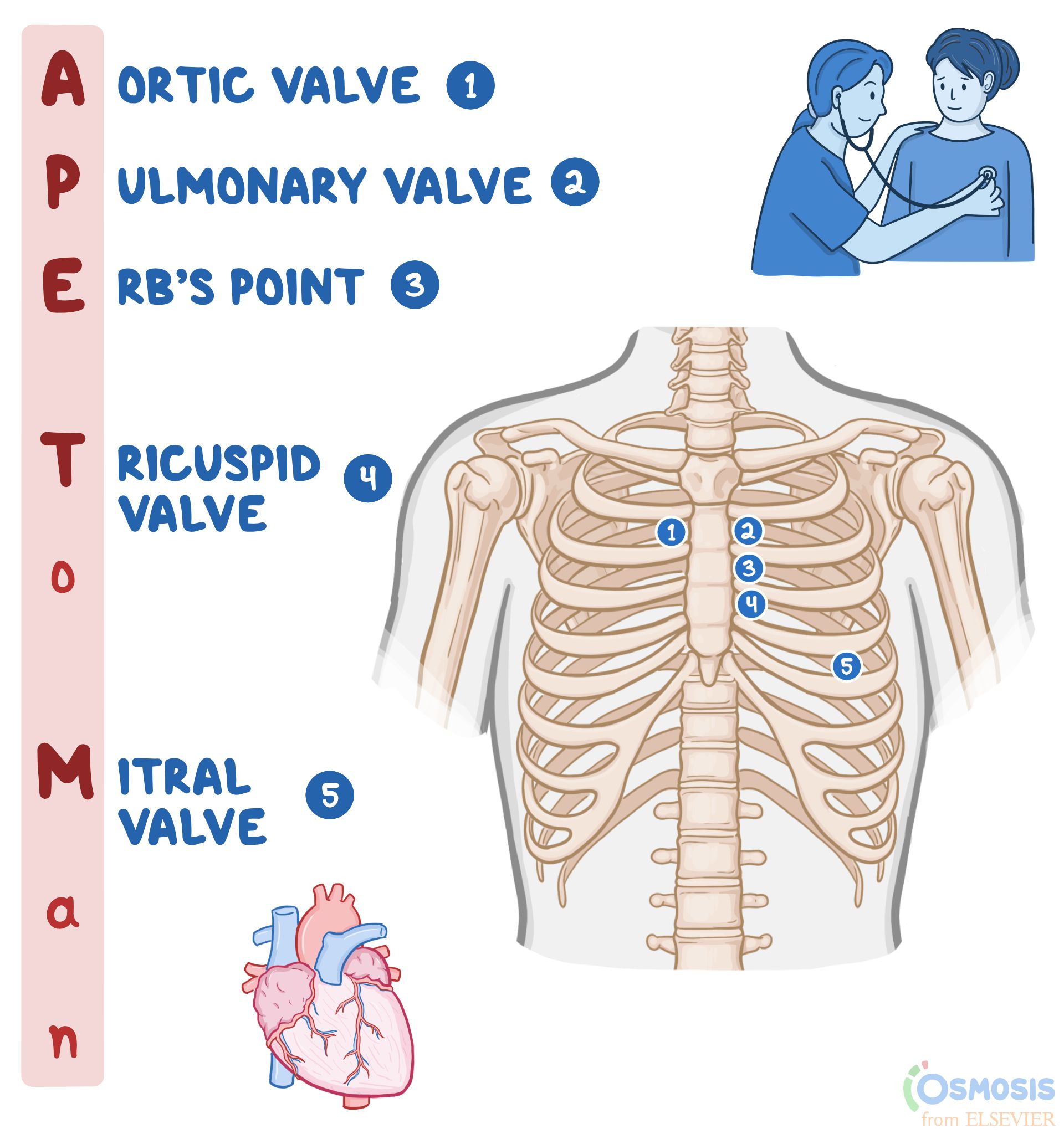The nurse is assessing the heart sounds of a client. The nurse understands that to listen to the pulmonic valve, the stethoscope should be placed where?
Fifth intercoastal space, left of the midclavicular line
Left lower sternal border
Second left intercoastal space
Second right intercoastal space
The Correct Answer is C
A. Fifth intercostal space, left of the midclavicular line: This placement is used to auscultate the mitral valve, which is best heard at the apex of the heart. The mitral valve sounds are typically heard around the fifth intercostal space, midclavicular line.
B. Left lower sternal border: This placement is used to auscultate the tricuspid valve, which is best heard at the lower left sternal border.
C. Second left intercostal space: This is the correct placement for auscultating the pulmonic valve. The pulmonic valve sounds are best heard at the second left intercostal space, which is close to the upper left sternal border.
D. Second right intercostal space: This placement is used to auscultate the aortic valve, which is best heard at the second right intercostal space, close to the upper right sternal border.

Nursing Test Bank
Naxlex Comprehensive Predictor Exams
Related Questions
Correct Answer is B
Explanation
A. Simultaneously palpating both arteries to compare amplitude: While comparing amplitudes is important, using the diaphragm of the stethoscope to listen for bruits (abnormal whooshing sounds indicating turbulent blood flow) is a more specific and accurate method for assessing the carotid arteries for potential vascular issues.
B. Listening with the diaphragm of the stethoscope to assess for bruits: This technique allows the nurse to detect abnormal sounds (bruits) that could indicate partial blockages or stenosis in the carotid arteries, suggesting a risk of stroke or transient ischemic attack.
C. Instructing the patient to take slow deep breaths during auscultation: Deep breaths are more relevant during lung auscultation. Carotid artery assessment focuses on detecting abnormal sounds and assessing blood flow rather than respiratory patterns.
D. Palpating the artery at the base of the neck: Palpation alone does not provide enough information about potential blockages or abnormalities in the carotid arteries. Listening with a stethoscope allows for a more detailed assessment of blood flow and the presence of bruits.f the nurse hears a bruit during auscultation, they shouldnotpalpate the carotid artery. A bruit suggests partial obstruction (carotid stenosis), and compressing the artery further could worsen blood flow.
Correct Answer is B
Explanation
A. Wheezing: Wheezing is a continuous, high-pitched whistling sound usually heard during expiration. It is often associated with narrowed airways, such as in asthma or chronic obstructive pulmonary disease (COPD). Wheezing occurs due to the turbulent airflow through narrowed bronchi or bronchioles and is not typically associated with pleuritis.
B. Friction rub: Pleuritis, or inflammation of the pleura, can cause a friction rub. This sound occurs when the inflamed pleural layers rub against each other during breathing. It's a grating or rubbing sound heard on auscultation and is a hallmark sign of pleuritis.
C. Stridor: Stridor is a high-pitched, harsh sound heard during inspiration and sometimes expiration. It is often a sign of upper airway obstruction, such as in croup or anaphylaxis. Stridor results from turbulent airflow through a partially obstructed or narrowed larynx or trachea.
D. Crackles: Crackles, also known as rales, are brief, discontinuous, popping sounds heard on inspiration. They can be fine or coarse and are often associated with conditions that cause fluid or secretions in the alveoli or small airways, such as pneumonia or heart failure. Crackles are not typically associated with pleuritis.
Whether you are a student looking to ace your exams or a practicing nurse seeking to enhance your expertise , our nursing education contents will empower you with the confidence and competence to make a difference in the lives of patients and become a respected leader in the healthcare field.
Visit Naxlex, invest in your future and unlock endless possibilities with our unparalleled nursing education contents today
Report Wrong Answer on the Current Question
Do you disagree with the answer? If yes, what is your expected answer? Explain.
Kindly be descriptive with the issue you are facing.
